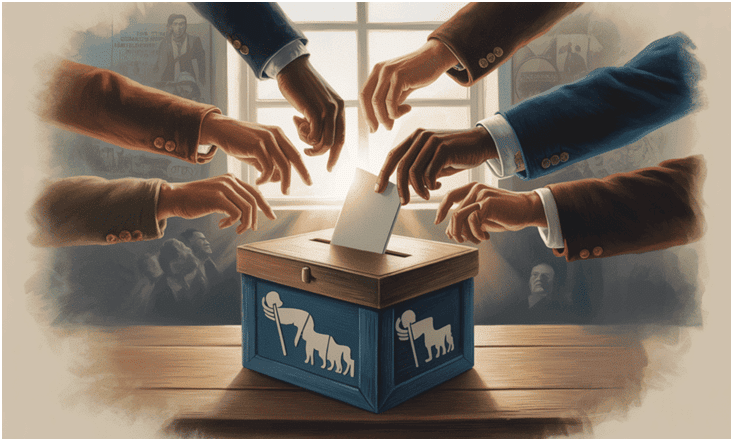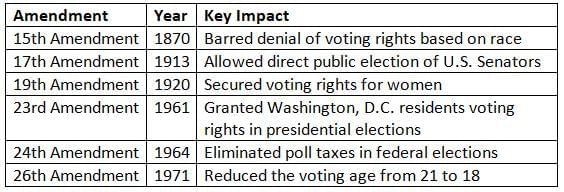Voting Rights and Models of Voting Behavior Chapter Notes | AP U.S Government and Politics - Grade 12 PDF Download
Introduction
Voting is a fundamental aspect of democratic engagement, yet in the United States, access to the ballot has not always been universal. Over the years, constitutional amendments and federal legislation have broadened suffrage to encompass a larger segment of the population, while various models of voting behavior shed light on the reasons and methods behind citizens’ electoral participation.
Constitutional Protections for Voting Rights

The U.S. Constitution grants states the authority to set voter qualifications and oversee elections. Historically, this led to discriminatory practices, particularly in southern states, where measures like literacy tests, poll taxes, grandfather clauses, and white primaries were used to disenfranchise Black Americans, women, and immigrants. Initially, only white male property owners—roughly 3% of the population—could vote. Over time, Constitutional amendments and laws expanded suffrage to include more groups.
Key Constitutional Amendments Expanding Suffrage

- The Fifteenth Amendment (1870): Enacted during the Reconstruction era, this amendment prohibited federal and state governments from restricting a citizen’s right to vote on account of race, color, or prior servitude. Despite its historic significance for racial equality, many states employed tactics like literacy tests, grandfather clauses, and white primaries to hinder Black voting.
- The Seventeenth Amendment (1913): Prior to this amendment, state legislatures appointed U.S. Senators. The 17th Amendment transferred this responsibility to the electorate, enhancing democratic accountability and curbing corruption within state politics.
- The Nineteenth Amendment (1920): Following decades of advocacy by leaders like Susan B. Anthony and Elizabeth Cady Stanton, this amendment ensured women’s right to vote, marking a pivotal advancement in gender equality within American politics.
- The Twenty-Third Amendment (1961): This amendment granted Washington, D.C. residents the ability to participate in presidential elections. Previously, D.C. citizens, despite paying federal taxes, were excluded from influencing the Electoral College. Though not part of the College Board CED, this amendment supports arguments about suffrage expansion in FRQs.
- The Twenty-Fourth Amendment (1964): Poll taxes were frequently used in Southern states to disenfranchise poor Black voters. This amendment outlawed such taxes in federal elections, representing a vital achievement of the Civil Rights Movement.
- The Voting Rights Act of 1965: Although not a constitutional amendment, this legislation stands as one of the most transformative voting rights measures in U.S. history. It prohibited literacy tests and enabled federal supervision of states with histories of discriminatory voting practices, reinforcing the Fifteenth Amendment and safeguarding minority voting rights.
- The Twenty-Sixth Amendment (1971): Amid the Vietnam War, 18-year-olds were conscripted but lacked voting rights. This amendment lowered the voting age to 18, acknowledging the political agency of younger citizens and reflecting the era’s youth activism.
Key Point: Section 5 of the Voting Rights Act mandated federal approval for changes to voting laws in certain states. While partially invalidated in Shelby County v. Holder (2013), the original Act was a critical milestone in ensuring ballot access.
Models of Voting Behavior
What drives individuals to vote as they do? Political scientists have devised several models to elucidate voting choices, each rooted in distinct motivations and levels of information.
Rational-Choice Voting
- In this model, voters act as rational decision-makers, selecting candidates whose policies align with their personal interests.
- For instance, a voter might support a candidate promising tax reductions if they believe it will enhance their financial situation, or back a candidate advocating student debt relief if it directly benefits them.
Example: A college student votes for a candidate promoting free tuition and student loan forgiveness.
Retrospective Voting
This model emphasizes past performance. Voters assess the record of the incumbent party or leader and decide whether to support or oppose them based on their governance.
Example: If voters are dissatisfied with economic conditions under a sitting president, they may opt for the opposing party in the subsequent election.
Prospective Voting
In contrast to retrospective voting, prospective voting focuses on the future. Voters evaluate candidates’ campaign promises and choose based on anticipated outcomes, requiring some trust in political pledges.
Example: In 2020, many voters backed Joe Biden due to his commitments to improve the handling of the COVID-19 pandemic compared to the incumbent administration.
Party-Line Voting
Many voters strongly align with a political party and consistently vote for its candidates, regardless of specific issues or individual candidate qualities. This is known as straight-ticket voting.
Key Point: Party-line voting can heighten political polarization, as party loyalty often supersedes independent evaluation of candidates or policies.
Conclusion
The evolution of voting rights in the United States has been marked by a series of hard-won constitutional amendments and legislative victories. While access to the ballot has expanded significantly, voter participation remains influenced by individual motivations, party affiliations, and institutional frameworks. Grasping both the legal underpinnings of suffrage and the factors driving voting behavior provides insight into patterns of political engagement in contemporary democracy.
Key Terms
- Fifteenth Amendment: Ratified in 1870, this amendment to the U.S. Constitution prohibits denying citizens the right to vote based on race, color, or previous servitude. A landmark in post-Civil War efforts to secure voting rights for African American men, it remains central to discussions of civil rights and voting access.
- Nineteenth Amendment: Adopted in 1920, this amendment granted women the legal right to vote, a culmination of the women’s suffrage movement. It significantly expanded political participation and representation for women in American society.
- Party-Line Voting: The practice of voters consistently supporting candidates from their preferred political party. This behavior underscores the influence of party loyalty on electoral choices, impacting both election results and legislative processes.
- Prospective Voting: A voting model where individuals choose candidates based on expectations of future performance and policy outcomes, focusing on campaign promises and proposed initiatives.
- Rational-Choice Voting: A theory suggesting voters make calculated decisions to support candidates or parties that best align with their personal interests, weighing policies and potential benefits.
- Retrospective Voting: A voting model where decisions are based on evaluations of an incumbent’s or party’s past performance, determining whether they merit re-election or replacement.
- Seventeenth Amendment: Ratified in 1913, this amendment established direct election of U.S. Senators by popular vote, replacing selection by state legislatures, enhancing democratic participation.
- Suffrage Expansion: The historical process of broadening voting rights to include more groups, overcoming barriers related to race, gender, and economic status, tied to civil rights and democracy.
- Twenty-Third Amendment: Ratified in 1961, this amendment granted Washington, D.C. residents the right to vote in presidential elections, addressing their prior disenfranchisement.
- Twenty-Sixth Amendment: Enacted in 1971, this amendment lowered the voting age to 18, ensuring young adults, particularly those drafted for military service, could participate in elections.
- Twenty-Fourth Amendment: Ratified in 1964, this amendment banned poll taxes in federal elections, removing economic barriers that disproportionately affected low-income and minority voters.
- Voting Rights Act: A 1965 federal law that eliminated discriminatory voting practices, such as literacy tests, and enforced minority voting rights, profoundly impacting electoral fairness.
FAQs on Voting Rights and Models of Voting Behavior Chapter Notes - AP U.S Government and Politics - Grade 12
| 1. What are the key protections for voting rights in the United States? |  |
| 2. What are the different models of voting behavior? |  |
| 3. How does voter turnout vary among different demographic groups? |  |
| 4. What impact does voter suppression have on elections? |  |
| 5. Why is understanding voting behavior important for democracy? |  |















